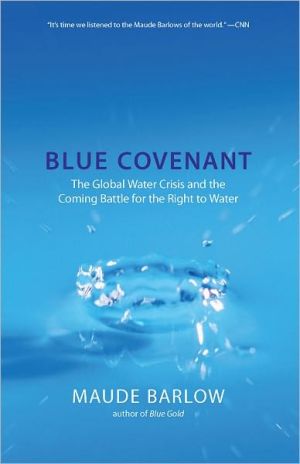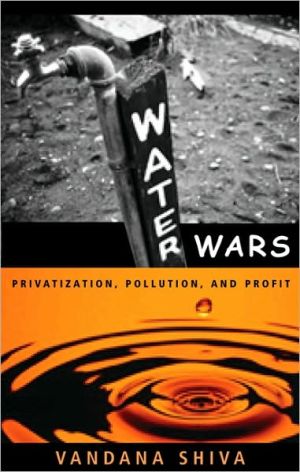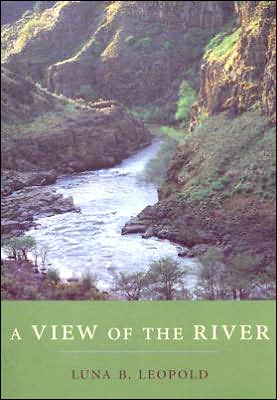Blue Covenant: The Global Water Crisis and the Coming Battle for the Right to Water
Maude Barlow has for decades been a leading voice arguing that access to safe drinking water should be a basic human right. Called the "Al Gore of water," Barlow is the very best kind of advocate-deeply informed, articulate, persuasive. Essential reading for anyone interested in the emerging international movement for water justice, Blue Covenant is one of the most important books of our time.
Search in google:
An Inconvenient Truth of water.“Imagine a world in twenty years, in which no substantive progress has been made to provide basic wastewater service in the Third World, or to force industry and industrial agriculture production to stop polluting water systems, or to curb the mass movement of water by pipeline, tanker and other diversion, which will have created huge new swaths of desert." “Desalination plants will ring the world’s oceans, many of them run by nuclear power; corporate nanotechnology will clean up sewage water and sell it to private utilities who will sell it back to us at a huge profit; the rich will drink only bottled water found in the few remote parts of the world left or sucked from the clouds by machines, while the poor die in increasing numbers. This is not science fiction. This is where the world is headed unless we change course.” — Maude BarlowDubbed “Canada’s best-known voice of dissent” by the CBC, Maude Barlow has proven herself again and again to be on the leading edge of issues Canadians care deeply about. In Blue Covenant, Barlow lays out the actions that we as global citizens must take to secure a water-just world — a “blue covenant” for all. Publishers Weekly Canadian antiglobalization activist Barlow (Blue Gold) calls for a "blue covenant" among nations to define the world's fresh water as "a human right and a public trust" rather than a commercial product. Barlow marshals facts and figures with admirable (if often dry) comprehensiveness, noting that as many as 36 U.S. states could reach a water crisis in five years; that once vast freshwater resources like Lake Chad and the Aral Sea are becoming briny puddles; and a handful of multinational water companies, abetted by World Bank monetary policies and United Nations political timidity, are bidding for the "complete commodification" of formerly public water resources. Her passionate plea for access-to-water activism is buttressed with some breakthroughs; Uruguay has enshrined public water rights in its constitution (the only nation to do so), and "water warriors" are fighting back in Bolivia, Argentina and Chile, where activists have forced private water companies to cede control of municipal water systems. There's a noble tilting-at-windmills quality to the author's call for private citizens and nongovernmental organizations to challenge corporate control of water delivery, agitate for equitable access to clean water and confront the reality that freshwater supplies are dwindling. (Feb.)Copyright 2007 Reed Business Information
Three scenarios collude toward disaster.\ Scenario one: The world is running out of freshwater. It is not just a question of finding the money to hook up the two billion people living in water-stressed regions of our world. Humanity is polluting, diverting and depleting the Earth’s finite water resources at a dangerous and steadily increasing rate. The abuse and displacement of water is the ground-level equivalent of greenhouse gas emissions, and likely as great a cause of climate change.\ Scenario two: Every day more and more people are living without access to clean water. As the ecological crisis deepens, so too does the human crisis. More children are killed by dirty water than by war, malaria, HIV/AIDS and traffic accidents combined. The global water crisis has become a most powerful symbol of the growing inequality in our world. While the wealthy enjoy boutique water at any time, millions of poor people have access only to contaminated water from local rivers and wells.\ Scenario three: A powerful corporate water cartel has emerged to seize control of every aspect of water for its own profit. Corporations deliver drinking water and take away wastewater; corporations put massive amounts of water in plastic bottles and sell it to us as at exorbitant prices; corporations are building sophisticated new technologies to recycle our dirty water and sell it back to us; corporations extract and move water by huge pipelines from watersheds and aquifers to sell to big cities and industries; corporations buy, store and trade water on the open market, like running shoes. Most importantly, corporations want governments to deregulate the water sector and allow the market to set water policy. Every day, they get closer to that goal. Scenario three deepens the crises now unfolding in scenarios one and two.\ Imagine a world in twenty years in which no substantive progress has been made to provide basic water services in the Third World; or to create laws to protect source water and force industry and industrial agriculture to stop polluting water systems; or to curb the mass movement of water by pipeline, tanker and other diversions, which will have created huge new swaths of desert. Desalination plants will ring the world’s oceans, many of them run by nuclear power; corporate-controlled nano-technology will clean up sewage water and sell it to private utilities, which will in turn sell it back to us at a huge profit; the rich will drink only bottled water found in the few remaining uncontaminated parts of the world, or sucked from the clouds by corporate-controlled machines, while the poor will die in increasing numbers from a lack of water.\ This is not science fiction. This is where the world is headed unless we change course — a moral and ecological imperative. But first we must come to terms with the dimension of the crisis.\ \ We Are Running Out of Freshwater\ \ In the first seven years of the new millennium, more studies, reports and books on the global water crisis have been published than in all of the preceding century. Almost every country has undertaken research to ascertain its water wealth and threats to its aquatic systems. Universities around the world are setting up departments or cross- departmental disciplines to study the effects of water shortages. Dozens of books have been written on all aspects of the crisis. The WorldWatch Institute has declared: “Water scarcity may be the most underappreciated global environmental challenge of our time.”\ From these substantial and recent undertakings, the verdict is in and irrefutable: the world is facing a water crisis due to pollution, climate change and a surging population growth of such magnitude that close to two billion people now live in waterstressed regions of the planet. Further, unless we change our ways, by the year 2025, two-thirds of the world’s population will face water scarcity. The global population tripled in the twentieth century, but water consumption went up sevenfold. By 2050, after we add another three billion to the population, humans will need an 80 percent increase in water supplies just to feed ourselves. No one knows where this water is going to come from.\ Scientists call them “hot stains” — the parts of the Earth now running out of potable water. They include Northern China, large areas of Asia and Africa, the Middle East, Australia, the Midwestern United States and sections of South America and Mexico.\ The worst examples in terms of the effect on people are, of course, those areas of the world with large populations and insufficient resources to provide sanitation. Two-fifths of the world’s people lack access to proper sanitation, which has led to massive outbreaks of waterborne diseases. Half of the world’s hospital beds are occupied by people with an easily preventable waterborne disease, and the World Health Organization reports that contaminated water is implicated in 80 percent of all sickness and disease worldwide. In the last decade, the number of children killed by diarrhea exceeded the number of people killed in all armed conflicts since the Second World War. Every eight seconds, a child dies from drinking dirty water.\ Some wealthier countries are just beginning to understand the depth of their own crisis, having adopted a model of unlimited consumer growth based on industrial, trade and farming practices that are wasting precious and irreplaceable water resources. Australia, the driest continent on Earth, is facing a severe shortage of water in all of its major cities, as well as widespread drought in its rural countryside. Annual rainfall is declining; salinity and desertification are spreading rapidly; rivers are being drained at an unsustainable rate; and more than one-quarter of all surface water management areas now exceed sustainable limits. Climate change is accelerating drought and causing freak storms and weather patterns just as the population is set to expand dramatically in the next twenty years. . . .
Acknowledgments ixIntroduction xiChapter 1 Where Has All the Water Gone? 1Chapter 2 Setting the Stage for Corporate Control of Water 34Chapter 3 The Water Hunters Move in 68Chapter 4 The Water Warriors Fight Back 102Chapter 5 The Future of Water 142Sources and Further Reading 177Index 185
\ Publishers WeeklyCanadian antiglobalization activist Barlow (Blue Gold) calls for a "blue covenant" among nations to define the world's fresh water as "a human right and a public trust" rather than a commercial product. Barlow marshals facts and figures with admirable (if often dry) comprehensiveness, noting that as many as 36 U.S. states could reach a water crisis in five years; that once vast freshwater resources like Lake Chad and the Aral Sea are becoming briny puddles; and a handful of multinational water companies, abetted by World Bank monetary policies and United Nations political timidity, are bidding for the "complete commodification" of formerly public water resources. Her passionate plea for access-to-water activism is buttressed with some breakthroughs; Uruguay has enshrined public water rights in its constitution (the only nation to do so), and "water warriors" are fighting back in Bolivia, Argentina and Chile, where activists have forced private water companies to cede control of municipal water systems. There's a noble tilting-at-windmills quality to the author's call for private citizens and nongovernmental organizations to challenge corporate control of water delivery, agitate for equitable access to clean water and confront the reality that freshwater supplies are dwindling. (Feb.)\ Copyright 2007 Reed Business Information\ \






